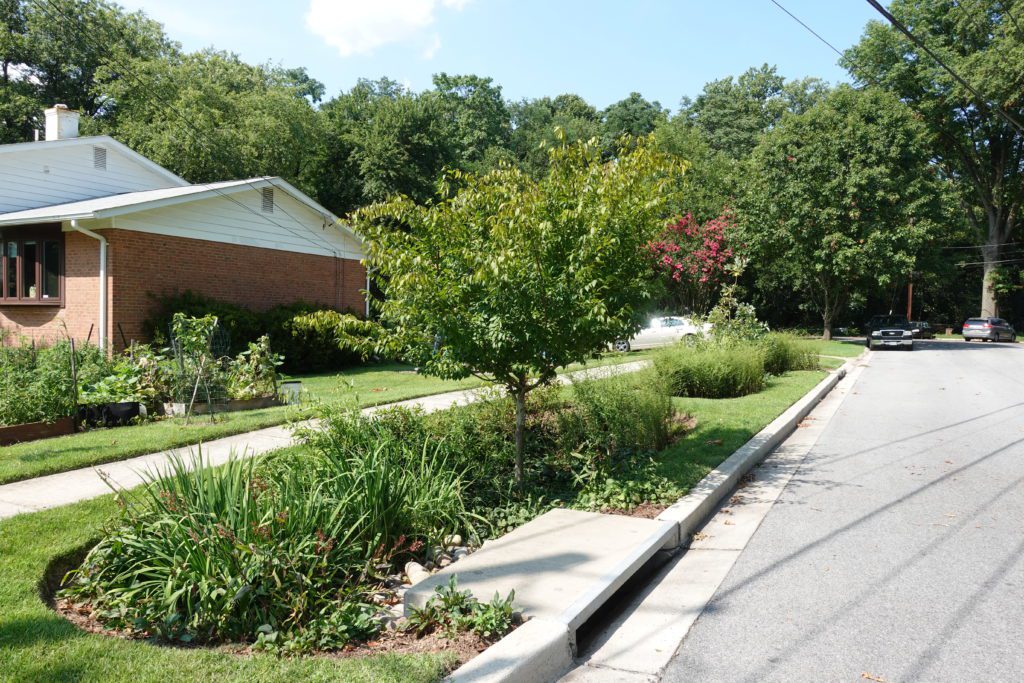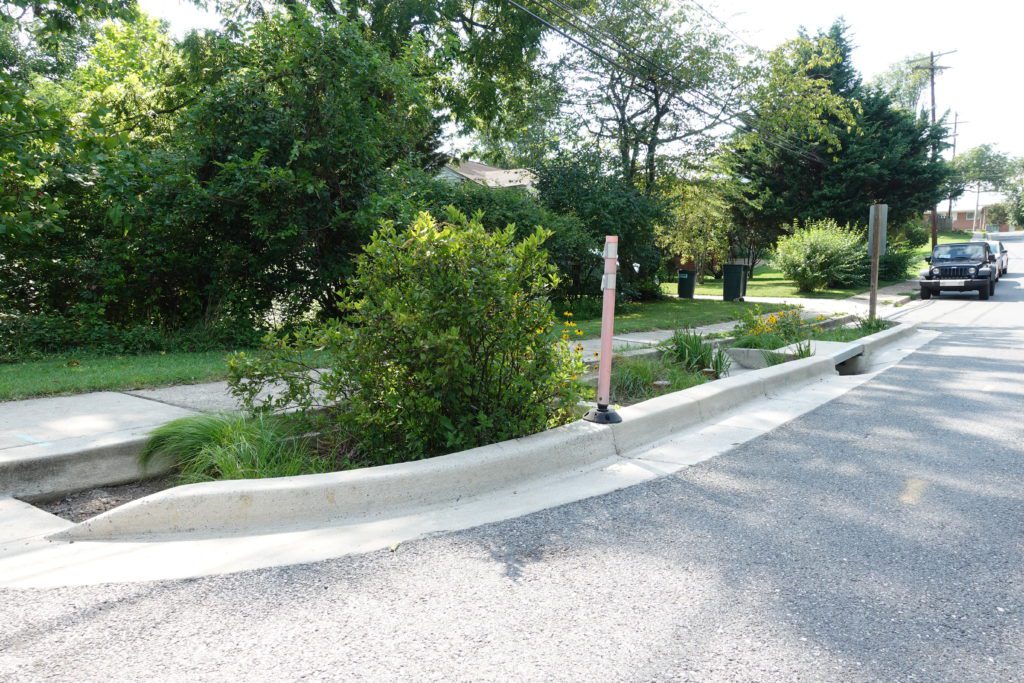Green Street Rain Gardens, Aesthetics, and Social Values
By Kate Cholakis and Eliza Pennypacker
Evenly trimmed lawns and crisply edged plant beds filled with dyed brown, red, or black mulch. Sheared evergreen shrubs and plants bred for vibrant flowers or patterned leaves. Plants spaced far apart within wide expanses of mulch—seasonal appearances of chrysanthemums, pansies, and other annuals. You may recognize this combination of landscape components and traits: the residential yard norm permeates the varied geographic regions of the U.S. and has withstood the test of time.
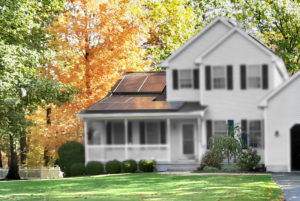
We tend to associate the yard norm with care, status, and work ethic. Residents communicate their care for the neighborhood community by maintaining a lush, neat landscape. Photo by Kate Cholakis.
This norm and its associated maintenance practices can negatively impact environmental and human health. Alternative approaches, such as converting lawns to pollinator meadows, woodland gardens, and rain gardens, can mitigate environmental impacts. Rain gardens, a type of green stormwater infrastructure (GSI), can provide habitat while reducing the amount of polluted stormwater runoff leaving a property. These concave planted areas typically replace lawns with a diversity of native grasses, perennials, shrubs, and trees. The plants and the interactions between their roots and the soil slow, filter, and infiltrate runoff.
In contrast, the conventional approach to stormwater management is conveying runoff from roads, lawns, and other surfaces to storm drains, through underground pipes, and directly into wetlands, rivers, and lakes with minimal or no treatment. Runoff from these surfaces can contain pollutants such as fertilizer, pesticide, herbicide, engine oil, salt, sediment, bacteria, and nutrients. These pollutants affect the health of aquatic life, which can impact recreational and commercial fishing, boating, wildlife viewing, and even property values. People can suffer illness from exposure to pollutants when swimming or ingesting contaminated fish. Rain gardens on residential properties can treat runoff from structures, lawns, and driveways, reducing these impacts. Municipalities recognize the capacity of rain gardens to mitigate runoff impacts and increasingly integrate rain gardens into the public streetscape through “green streets” projects. Towns, cities, and counties install rain gardens in parking lanes, grass verges, and even parts of adjacent yards that fall within the public right-of-way.
- Green Streets projects may incorporate rain gardens into the yards and grass verges along the street (left)
- or into the road shoulder/parking lane (right). Photos by Alex Kim.
The federal government’s National Pollutant Discharge Elimination System (NPDES) requires certain entities to obtain stormwater permits, and GSI, such as green street rain gardens, can help with compliance. These regulated entities include MS4s (Municipal Separate Storm Sewer Systems), which convey stormwater directly to water bodies via drains and underground pipes. MS4s can include cities and towns, military bases, and public college campuses and hospitals. Some municipalities combine runoff and sewage in the same pipe (known as a combined sewer system), which can overflow into rivers during large rain events. These municipalities also need stormwater permits, as do developers disturbing over an acre of land for construction. Cities and towns may impose additional stormwater regulations on these and other entities. In total, this is a significant amount of land in the U.S. subject to stormwater regulations and thus a significant opportunity for intervention.
Rain Garden Perceptions
Green street rain gardens seem like a benign solution. Though there has been widespread support, resistance sometimes occurs and can lead to the cancellation of city projects (see Dil 2019, Giuliani 2020, Nir 2017, Reed 2018, and Wiley n.d.). Appearance is indeed a factor: some residents describe rain gardens as “unkempt,” “wild,” and “overgrown” (Everett et al., 2018, Turner et al., 2016). To enhance the successful integration of green street rain gardens into our stormwater management toolkit, we need to know: what are the components and qualities of rain gardens that people interpret as unkempt and overgrown, and why are these perceptions so influential?
In 2021, a research study investigated these questions by examining robust green streets projects in Montgomery County, Maryland, and Kansas City, Missouri. The choice of these two locations relates to the similarities in their approach to municipal green streets projects and differences in income, population, and the stormwater regulations to which they must comply. The study interviewed municipal employees implementing green streets programs and design consultants who worked on green streets projects. These professionals encountered public reaction on multiple projects over time. The interviewees reflected on green streets projects installed in residential areas: this context seemed to be where residents in previous studies and the media had the strongest reactions. This trend is not surprising: these green street rain gardens are installed in the city right of way in front of single-family homes—but that line isn’t always obvious in the landscape. The grass verge can be seen as part of the yard and a reflection of its owner. A resident’s negative comment in a news segment encapsulates this dynamic: “[The County] is trying to convince [residents]… rain gardens in their front yards on the county’s right of way are a good idea” (Taylor 2017).
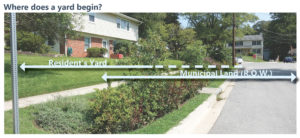
The area in front of a residence is often interpreted as a reflection of its owner. Photo by Alex Kim.
Even so, why might a rain garden in the front yard be problematic? First, let’s acknowledge key differences between rain gardens and the residential “landscape norm.” Rain gardens take a concave form in the landscape. These low points are densely planted with tall grasses, perennials, shrubs, and trees. The species chosen tend to be native to the region and are less commonly found in box store nurseries. Dormant (brown) herbaceous vegetation is often left standing in the fall and perhaps through the winter. Why would these particular differences cause opposition? Existing research and theory concerning residential landscapes provide critical insight. In the 1980s and 1990s, two landscape architecture scholars, Joan Nassauer and Eliza Pennypacker identified relationships between yard components and social values. Pennypacker drew connections between greenness (lawn, shade trees, evergreen shrubs) and health, leisure, and luxury; between openness (expanses of lawn) and transparency and neighborliness; and between scrupulous maintenance (as seen in neatness) and status, work ethic, and civic responsibility (Pennypacker 1992). Nassauer posited that these traits form an “aesthetic of care,” a recognizable language of human intention (Nassauer 1988).
Given these associations, it is not surprising that researchers have observed that residents’ personal preferences are not consistently what you’ll find in their front yards. Front yards usually respond to the yard norm, even if the owner does not actually like this aesthetic (Cook et al., 2012, Larsen and Harlan, 2006). People tend to express their personalities and desires more so in the relative privacy of their backyards. Even environmental values struggle to compete with concern for the social values of neighborliness and status. In studies of land management behaviors, environmental values and knowledge do not consistently correlate with the use of ecological landscaping practices (e.g., Robbins and Sharp 2003, Carrico et al. 2012). Is it possible to adjust the design of the rain garden to express social values associated with the yard norm, such as neighborliness, status, work ethic, and civic responsibility? How can rain garden design incorporate an aesthetic of care?
Study Findings: Green Street Rain Garden Design and Public Reaction
Four categories of findings emerged through the interviews with green streets program managers and designers:
- A selection of rain garden aesthetic components and traits to which people react positively.
- Relationships between these components/traits and the perception of care and neglect.
- Community engagement strategies to increase acceptance of rain gardens (e.g., giving residents agency in the design process).
- Adjustments made to rain gardens after installation, which also affect aesthetic reactions (e.g., resident interventions and maintenance challenges).
Detailed findings can be accessed via Penn State’s digital library and will be elaborated upon in an ELA Focus on Sustainability webinar in fall 2022. However, key takeaways from the first theme are summarized below.
Residents reacted most positively to these aesthetic components and traits:
- Constrained height of herbaceous vegetation (maximum 18”)
- Controlled, compact growth habit of plants (plants that do not droop or spread into other plants)
- Planting no more than 50% of the rain garden with tall grasses
- Mid-range plant diversity (not a monoculture, but not too much variation)
- Recognizable/familiar plants (e.g., sedum, daylilies)
- Flowers (but not brown seedheads)
- Year-round interest (e.g., evergreens, berries, flowers) but no brown foliage
- Planted area appears lush but is not seemingly overgrown (plants do not extend beyond the rain garden edge)
- Defined edges (e.g., shoveled edge, mulch strip, hardscape edging)
- Noticeable patterns of plant arrangement (e.g., rows, clusters of species, repeated clusters throughout the bed, the visible distinction between vertical layers, geometric bones formed by hardscaping or shrubs, familiar plants around the outer edges with less familiar native plants in the bottom)
- Avoiding species with “weed” in the name
- Boulders, ledges, stone walls, or water features
- Benches, art, or educational signs
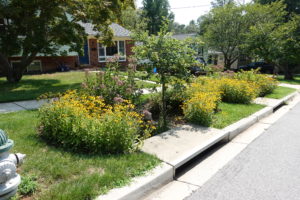
Residents seek signs of care in the rain garden, such as noticeable patterns of plant arrangement, defined edges, and flowers. Photo by Alex Kim.
These findings align with research in environmental psychology. Rachel and Stephen Kaplan investigated how people respond to aesthetic traits as a result of our evolutionary history and physiology. These traits include a balance between legibility and coherence—feeling safe by understanding what you see, why it’s there, and how it functions—and mystery and complexity, which satisfy curiosity (Kaplan and Kaplan 1982). We can be drawn to something different as long as we recognize and understand parts of it. Interviewee comments about signs prompt a related question: Can knowledge influence the aesthetic appreciation of an object? Philosophers such as Marcia Eaton suggest this is possible (Eaton 1997), though perhaps our knowledge allows us to value the object for another reason rather than actually changing our aesthetic reaction.
Furthermore, the field of environmental behavior has shown that knowledge alone is not a reliable driver of behavioral change. Research suggests that explaining the salience of the issue to residents’ everyday lives, showing how a strategy could work toward other values they may have, and sparking peoples’ curiosity are likely to be more effective than simply sharing information (O’Neill and Nicholson-Cole 2009, Kahan et al. 2017, Wolsko et al. 2016). To summarize, combining educational and design strategies to communicate function and draw interest while offering a degree of familiarity could help with green street rain garden acceptance. Achieving that balance, though, is not likely to be easy. There seems to be a narrow threshold between what is acceptable and not acceptable. The ideal state—between a garden being lush but not overgrown or just biodiverse enough—may be difficult to design and maintain.
And what are the consequences? Data analysis revealed associations between rain garden components and the two social values of perceived care and neglect. This aligns with Nassauer’s theory: elements associated with care—defined edges, noticeable patterns of plant arrangement, lushness—are positively valued. It is possible that characteristics such as tall grasses and brown vegetation remind residents of vacant lots where maintenance has been neglected. Residents seek signs of care in the green street rain garden and do not always find them.
Given this potential correlation, what can we do to suggest care in the landscape without compromising ecological function? Nassauer presented a strategy in 1995 for integrating ecological landscapes into the built environment—this involves using cues to care to frame less familiar ecological components (messy ecosystems) with familiar patterns and objects (orderly frames) (Nassauer 1995). Utilizing the strategies in the bulleted list above while also integrating the plants and design strategies critical for stormwater mitigation may improve the likelihood of public acceptance.
We extend gratitude for the insight shared by the interviewees—Kansas City and Montgomery County municipal staff and designers—and encourage readers to learn more about their programs: KC Green Infrastructure and MC Green Streets.
References
Carrico, Amanda R., James Fraser, and Joshua T. Bazuin. 2012. “Green with Envy: Psychological and Social Predictors of Lawn Fertilizer Application.” Environment and Behavior 45, no. 4: 427-454. https://journals-sagepub-com.ezaccess.libraries.psu.edu/doi/full/10.1177/0013916511434637.
Cook, Elizabeth M., Sharon J. Hall, and Kelli L. Larson. 2012. “Residential Landscapes as Social-Ecological Systems: A Synthesis of Multi-scalar Interactions between People and Their Home Environment.” Urban Ecosystems 15, no. 1: 19–52. https://doi.org/10.1007/s11252-011-0197-0.
Copeland, Claudia. 2016. “Clean Water Act: A Summary of the Law.” Congressional Research Service https://www.crs.gov.
Dil, Cuneyt. 2019. “Next to Rock Creek Park, Neighborhood Resistance to District’s Rain Gardens on City Streets.” The DC Line, February 13, 2019. https://thedcline.org/2019/02/13/next-to-rock-creek-park-neighborhood-resistance-to-districts-rain-gardens-on-city-streets/.
Eaton, Marcia Muelder. 1997. “The Beauty that Requires Health.” In Placing Nature: Culture and Landscape Ecology, edited by Joan Iverson Nassauer, 85-106. Washington D.C.: Island Press.
EPA. “National Summary of State Information.” Water Quality Assessment and TMDL Information. Accessed September 19, 2020. https://www.epa.gov/tmdl.
Everett, Glyn, Jessica Lamond, Anita Morzillo, A Marissa Matsler, and Faith Chan. 2018. “Delivering Green Streets: An Exploration of Changing Perceptions and Behaviors over Time around Bioswales in Portland, Oregon.” Journal of Flood Risk Management 11, no. S2: S973–85. https://doi.org/10.1111/jfr3.12225.
Giuliani, David. 2020. “Rain Gardens Opposed in Western Springs Subdivision.” Patch, November 13, 2020. https://patch.com/illinois/westernsprings/rain-gardens-opposed-western-springs-subdivision.
Kahan, Dan, Laura Helft, Katie Carpenter, Asheley Landrum, and Kathleen Hall Jamieson. 2017. “Science Curiosity and Political Information Processing.” Political Psychology 38: 179-199. https://onlinelibrary.wiley.com/doi/10.1111/pops.12396.
Kaplan, Rachel, and Stephen Kaplan, eds. 1982. Humanscape: Environments for People. Ann Arbor, MI: Ulrich’s.
Larsen, Larissa, and Sharon L. Harlan. 2006. “Desert Dreamscapes: Residential Landscape Preference and Behavior.” Landscape and Urban Planning 78: 85-100. https://doi.org/10.1016/j.landurbplan.2005.06.002.
Nassauer, Joan Iverson. 1988b. “The Aesthetics of Horticulture: Neatness as a Form of Care.” HortScience 23, no. 6: 973-977.
Nassauer, Joan Iverson. 1995. “Messy Ecosystems, Orderly Frames.” Landscape Journal 14, 2: 161–70.
Nir, Sarah Maslin. 2017. “To the City, a Pollution Fighter. To Some Residents, an Eyesore.” The New York Times, March 23, 2017. https://www.nytimes.com/2017/03/23/nyregion/bioswale-rain-gardens-new-york.html.
O’Neill, Saffron, and Sophie Nicholson-Cole. 2009. “‘Fear Won’t Do It’: Promoting Positive Engagement With Climate Change Through Visual and Iconic Representations.” Science Communication 30, no. 3: 355-379. http://journals.sagepub.com/doi/10.1177/1075547008329201.
Pennypacker, Eliza. 1992. “What is Taste, and Why Should I Care?” Design + Values CELA Conference Proceedings IV: 63-73.
Reed, Dan. 2018. “Montgomery Residents are Fighting Plans to Build Rain Gardens.” Greater Greater Washington, April 12, 2018. https://ggwash.org/view/67222/montgomery-residents-are-fighting-plans-to-build-rain-gardens.
Robbins, Paul, and Julie T. Sharp. 2003. “Producing and Consuming Chemicals: The Moral Economy of the American Lawn.” Economic Geography 79, no. 4: 425-451. https://www.jstor.org/stable/30032947.
Taylor, Scott. 2017. “Montgomery County Homeowners Upset Over ‘Rain Gardens’.” ABC7, March 2, 2017. https://wjla.com/news/local/montgomery-county-homeowners-upset-over-rain-gardens.
Turner, V. Kelly, Kimberly Jarden, and Anne Jefferson. 2016. “Resident Perspectives on Green Infrastructure in an Experimental Suburban Stormwater Management Program.” Cities and the Environment (CATE) 9, no. 1. https://digitalcommons.lmu.edu/cate/vol9/iss1/4.
Wiley, Chelsea. n.d. “Clintonville Is Unhappy Again, This Time It’s All About The Rain Gardens.” Columbus Navigator https://www.columbusnavigator.com/clintonville-rain-gardens-controversy-2017/.
Wolsko, Christopher, Hector Ariceaga, and Jesse Seiden. 2016. “Red, White, and Blue Enough to Be Green: Effects of Moral Framing on Climate Change Attitudes and Conservation Behaviors.” Journal of Experimental Social Psychology 65: 7-19. https://linkinghub.elsevier.com/retrieve/pii/S0022103116301056.
About the Authors
Kate Cholakis is conducting research examining the intersections of sustainable stormwater management, landscape perception, and environmental behavior. She teaches ecological design and planning within the Conway School’s graduate program, and her professional practice experience involves green infrastructure planning and design and ecological approaches to land management. Kate earned her BA in Architecture from Smith College, MA from the Conway School, and MSLA from Penn State University. She is a LEED Green Associate.
Eliza Pennypacker is a Professor of Landscape Architecture at Penn State University. Since 2005 she has conducted research with Stuart Echols on “Artful Rainwater Design”: sustainable stormwater management that celebrates the rain in a way that is entertaining and enlightening. She and Echols have presented and published extensively on the subject, including their 2015 book, Artful Rainwater Design: Creative Ways to Manage Stormwater (Island Press).
***
Each author appearing herein retains original copyright. Right to reproduce or disseminate all material herein, including to Columbia University Library’s CAUSEWAY Project, is otherwise reserved by ELA. Please contact ELA for permission to reprint.
Mention of products is not intended to constitute endorsement. Opinions expressed in this newsletter article do not necessarily represent those of ELA’s directors, staff, or members.

